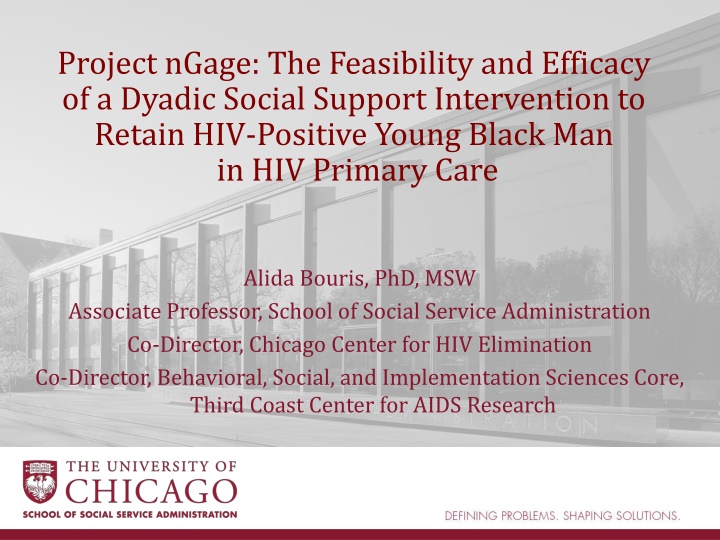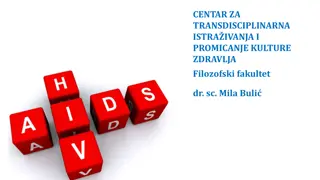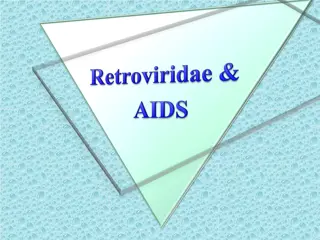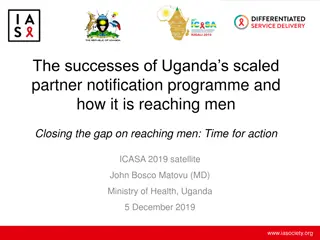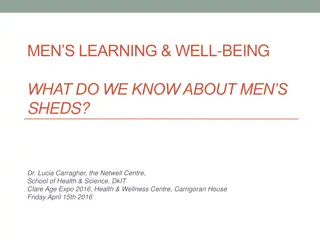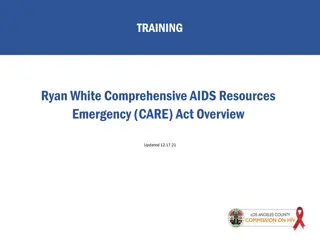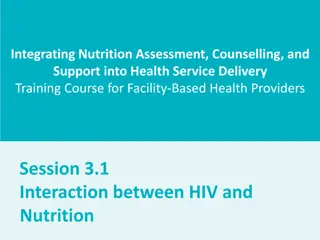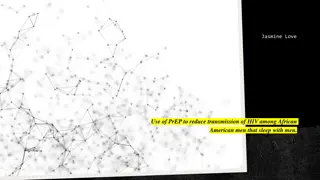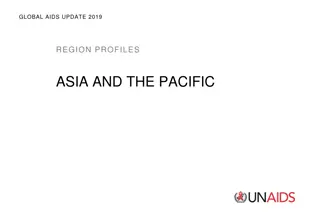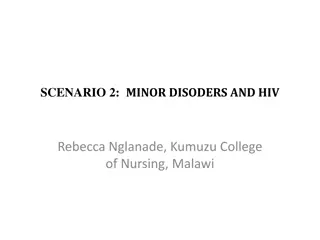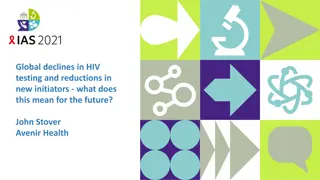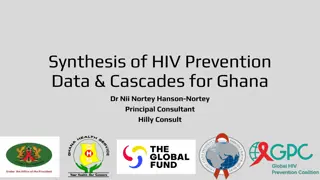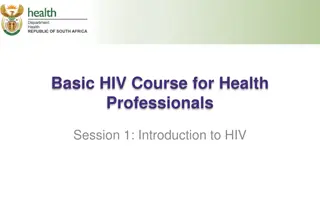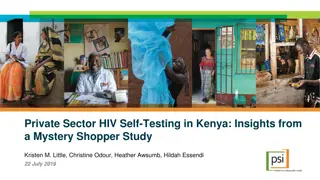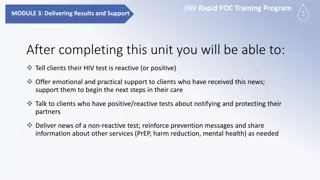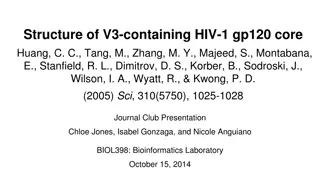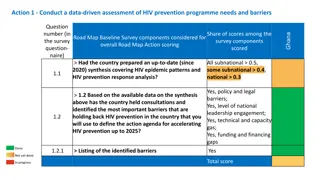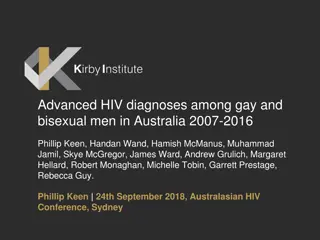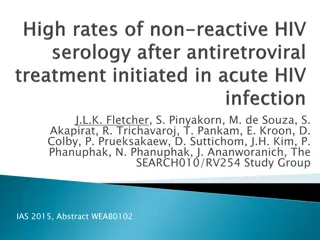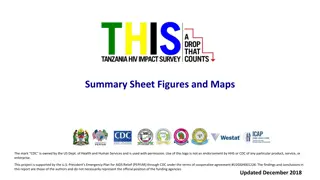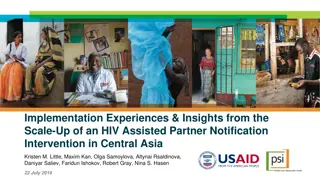Project nGage: Dyadic Social Support Intervention for HIV-Positive Young Black Men
Research led by Alida Bouris focuses on the feasibility and efficacy of a dyadic social support intervention to retain HIV-positive young Black men in HIV primary care. Supported by the National Institute of Mental Health, the project aims to enhance engagement in care and improve health outcomes through innovative approaches. The Chicago Center for HIV Elimination plays a key role in implementing the intervention and conducting a randomized controlled trial to assess its impact. By targeting social networks and providing tailored support, the project strives to reduce new HIV transmission events and promote holistic well-being in the community.
Download Presentation

Please find below an Image/Link to download the presentation.
The content on the website is provided AS IS for your information and personal use only. It may not be sold, licensed, or shared on other websites without obtaining consent from the author.If you encounter any issues during the download, it is possible that the publisher has removed the file from their server.
You are allowed to download the files provided on this website for personal or commercial use, subject to the condition that they are used lawfully. All files are the property of their respective owners.
The content on the website is provided AS IS for your information and personal use only. It may not be sold, licensed, or shared on other websites without obtaining consent from the author.
E N D
Presentation Transcript
Project nGage: The Feasibility and Efficacy of a Dyadic Social Support Intervention to Retain HIV-Positive Young Black Man in HIV Primary Care Alida Bouris, PhD, MSW Associate Professor, School of Social Service Administration Co-Director, Chicago Center for HIV Elimination Co-Director, Behavioral, Social, and Implementation Sciences Core, Third Coast Center for AIDS Research
Acknowledgments Funding: National Institute of Mental Health R34MH097622: Network Supported Engagement in HIV Care for Younger Black Men and Transgender Women. ClinicalTrials.gov Identifier: NCT01726712. Investigative Team: PIs: John Schneider, MD, MPH and Dexter Voisin, PhD, LCSW. Co-Is: Alida Bouris, PhD, MSW and Lisa Kuhns, PhD, MPH. Research Team: Rebecca Eavou, MSW, Kate Jaffe, MS, Natasha Flatt, MSW, and Molly Pilloton, MPH I have no commercial interests, financial relationships, or conflicts of interest to declare.
Overview Chicago Center for HIV Elimination: Network and contextual approaches Epidemiology of HIV/AIDS and the Continuum of Care Social networks and support for people living with HIV Project nGage: Randomized Controlled Trial to retain young Black men in HIV care Background and development Intervention Overview Results: Feasibility, Acceptability and Efficacy Discussion and Q and A
Chicago Center for HIV Elimination Mission: To eliminate new HIV transmission events over the next 30 years (from 2011 to 2041) by using network science to target and integrate prevention, as well as create structural and community-specific interventions. Social Networks for people at risk for and living with HIV Affective, relational and contextual factors Romantic / Sexual Partners Friends Family
Chicago Center for HIV Elimination Case management HIV counseling and testing Linkage to care Partner notification services Pre- and post-exposure prophylaxis (PEP / PrEP) Incarceration and criminal legal system involvement Youth engagement and leadership House-ball community events Substance abuse Sexual health and mental health Medication adherence Retention in care: Project nGage, Project WERK, PS-PrEP
5/ 1 0 / 2 0 1 8 Ch i c a g o r e c o r d s l o we st n u mb e r o f n e w HI V d i a g n o se s i n 2 6 y e a r s, December 1, 2017 o f f i c i a l s sa y - Ch i c a g o T r i b u n e Chicago records lowest number of new HIV diagnoses in 26 years, officials say 55% decline in new HIV infections from 2001 to 2016 Affordable Care Act: 12,000 PLWH received health coverage Treatment as Prevention: undetectable = untransmissible Pre-Exposure Prophylaxis: up to 92% protection Progress is uneven In 2016, Black MSM accounted for 58.5% of new HIV cases 2.7 times higher than Latinx MSM 4.0 times higher than White MSM 20-29 year olds carry highest burden Black MSM less likely to be virally suppressed and on PrEP and experience significant structural barriers. CDPH, 2017; GTZ, 2017 h t t p : / / www. c h i c a g o t r i b u n e . c o m/ n e ws/ l o c a l / b r e a k i n g / c t - me t - c h i c a g o - h i v - d i a g n o se s- d e c l i n e - 2 0 1 7 - st o r y . h t ml 1 / 4
Illinois Getting to Zero Campaign Goal: Eliminate HIV in Chicago by 2030 (or earlier) Increase current rates of PrEP and HIV treatment by 20% < 100 new cases in IL by 2027 90/90/90 90% of people with HIV diagnosed 90% of those diagnosed linked to care 90% of those in care virally suppressed Focus on Continuum of Care for people living with HIV
The HIV Continuum of Care, US, 2014 CDC, 2017
HIV Continuum of Care by Race/Ethnicity, US, 2014 CDC, 2017
HIV Continuum of Care by Age, US, 2014 CDC, 2017
SECTION ONE: HIV & STIs IN CHICAGO, 2016 SECTION ONE: HIV & STIs IN CHICAGO, 2016 Figure 1.1: HIV Continuum of Care Among Cases 13 Years and Older, Chicago, 2016 (as of /26/201 ) with 2020 National HIV/AIDS Strategy Indicators Figure 1.1: HIV Continuum of Care Among Cases 13 Years and Older, Chicago, 2016 (as of /26/201 ) with 2020 National HIV/AIDS Strategy Indicators -6(red) -6(red) (a) Number of persons 13 years of age at diagnosis with HIV infection between 1/1/2016 and 12/31/2016 (a) Number of persons 13 years of age at diagnosis with HIV infection between 1/1/2016 and 12/31/2016 Source Chicago ehanced HIV/AIDS reporting system (eHARS) (as of /26/201 ) NHAS output, Lin 1 able Source Chicago ehanced HIV/AIDS reporting system (eHARS) (as of /26/201 ) NHAS output, Lin 1 able CDPH, 2017 (b) Percent of persons 13 years of age lin ed to care (at least one CD , Viral Load (VL), or HIV-1 genotype test) within 1 month of HIV diagnosis among those diagnosed with HIV infection between 1/1/2016 and 12/31/2016 Source Chicago ehanced HIV/AIDS reporting system (eHARS) (as of /26/201 ) NHAS output, Lin 1 able Source Chicago ehanced HIV/AIDS reporting system (eHARS) (as of /26/201 ) NHAS output, Lin 1 able (b) Percent of persons 13 years of age lin ed to care (at least one CD , Viral Load (VL), or HIV-1 genotype test) within 1 month of HIV diagnosis among those diagnosed with HIV infection between 1/1/2016 and 12/31/2016 (c) Percent of persons 13 years of age lin ed to care (at least one CD , VL, or HIV-1 genotype test) within 3 months of HIV diagnosis among those diagnosed with HIV infection between 1/1/2016 and 12/31/2016 Source Chicago ehanced HIV/AIDS reporting system (eHARS) (as of /26/201 ) NHAS output, Lin 1 able Source Chicago ehanced HIV/AIDS reporting system (eHARS) (as of /26/201 ) NHAS output, Lin 1 able (c) Percent of persons 13 years of age lin ed to care (at least one CD , VL, or HIV-1 genotype test) within 3 months of HIV diagnosis among those diagnosed with HIV infection between 1/1/2016 and 12/31/2016 (d) Percent of persons 13 years of age lin ed to care (at least one CD , VL, or HIV-1 genotype test) within 6 months of HIV diagnosis among those diagnosed with HIV infection between 1/1/2016 and 12/31/2016 Source Chicago ehanced HIV/AIDS reporting system (eHARS) (as of /26/201 ) NHAS output, Lin 1 able 6 months of HIV diagnosis among those diagnosed with HIV infection between 1/1/2016 and 12/31/2016 Source Chicago ehanced HIV/AIDS reporting system (eHARS) (as of /26/201 ) NHAS output, Lin 1 able (d) Percent of persons 13 years of age lin ed to care (at least one CD , VL, or HIV-1 genotype test) within (e) Percent of persons 13 years of age lin ed to care (at least one CD , VL, or HIV-1 genotype test) within 12 months of HIV diagnosis among those diagnosed with HIV infection between 1/1/2016 and 12/31/2016 Source Chicago ehanced HIV/AIDS reporting system (eHARS) (as of /26/201 ) NHAS output, Lin 1 able 12 months of HIV diagnosis among those diagnosed with HIV infection between 1/1/2016 and 12/31/2016 Source Chicago ehanced HIV/AIDS reporting system (eHARS) (as of /26/201 ) NHAS output, Lin 1 able (e) Percent of persons 13 years of age lin ed to care (at least one CD , VL, or HIV-1 genotype test) within (f) Number of persons 13 years of age on 12/31/2015 diagnosed with HIV through 12/31/2015 and living with HIV on 12/31/2016 Source Chicago ehanced HIV/AIDS reporting system (eHARS) (as of /26/201 ) NHAS output, Care1 and VL1 ables with HIV on 12/31/2016 Source Chicago ehanced HIV/AIDS reporting system (eHARS) (as of /26/201 ) NHAS output, Care1 and VL1 ables (f) Number of persons 13 years of age on 12/31/2015 diagnosed with HIV through 12/31/2015 and living (h) Number of persons 13 years of age on 12/31/2015 diagnosed with HIV through 12/31/2015 and living with HIV on 12/31/2016 who received at least two medical care visits (at least one CD or VL at each), 3 months apart, between anuary 2016 and Decemeber 2016 Source Chicago ehanced HIV/AIDS reporting system (eHARS) (as of /26/201 ) NHAS output, Care1 able apart, between anuary 2016 and Decemeber 2016 Source Chicago ehanced HIV/AIDS reporting system (eHARS) (as of /26/201 ) NHAS output, Care1 able (h) Number of persons 13 years of age on 12/31/2015 diagnosed with HIV through 12/31/2015 and living with HIV on 12/31/2016 who received at least two medical care visits (at least one CD or VL at each), 3 months (i) Number of persons 13 years of age on 12/31/2015 diagnosed with HIV through 12/31/2015 and living with HIV on 12/31/2016 who received at least one VL test in the past 12 months Source Chicago ehanced HIV/AIDS reporting system (eHARS) (as of /26/201 ) NHAS output, VL1 able (i) Number of persons 13 years of age on 12/31/2015 diagnosed with HIV through 12/31/2015 and living with HIV on 12/31/2016 who received at least one VL test in the past 12 months Source Chicago ehanced HIV/AIDS reporting system (eHARS) (as of /26/201 ) NHAS output, VL1 able ( ) Percent of persons 13 years of age on 12/31/2015 diagnosed with HIV through 12/31/2015 and living with HIV on 12/31/2016 whose most recent VL test result was 200 copies /mL Source Chicago ehanced HIV/AIDS reporting system (eHARS) (as of /26/201 ) NHAS output, VL1 able ( ) Percent of persons 13 years of age on 12/31/2015 diagnosed with HIV through 12/31/2015 and living with HIV on 12/31/2016 whose most recent VL test result was 200 copies /mL Source Chicago ehanced HIV/AIDS reporting system (eHARS) (as of /26/201 ) NHAS output, VL1 able 19 19
Continuum of Care for YBMSM N = 626 YBMSM ages 16-26, Project Uconnect Schneider et al., 2014
Retention in Care is Key Why focus on retention in care? Key intermediate step in Continuum of Care Connect to medical, mental health and substance abuse care, and other health and social services Chronic disease screening Maintain HIV primary care and medication management Individual health and longevity Missed appointments associated with virologic failure and death (Giordano et al., 2007)
Retention in Care Interventions Few randomized controlled trials (RCTs) testing interventions to increase retention in care for YBMSM. Five general strategies to retain in care exist: Peer support groups Multi-modal peer outreach Intensified case management Peer health navigators Financial incentives Rely on external supports: long-term sustainability?
Missing: Organic Social Support Often construe social support as non-human support (housing, entitlements, etc.) or exogenous resources Overlook naturally existing sources of social support: Family, friends, partners, mentors, etc. Social support key for people living with HIV and other chronic conditions Messenger is more important than message Perceived expertise, trustworthiness and accessibility (Bouris et al., 2013; McFadden et al., 2014; Schneider et al., 2012)
Social Support for PLWH Endogenous supports underutilized due to fears of stigma or discrimination Ongoing and real: associated with higher viral load (Quinn et al., 2017) Social networks emerging as key explanatory factor in HIV epidemic: support, resources, stress and viral load Social network approaches: flexible way to identify the most supportive person(s) in people s networks Avoids a priori assumptions Selects based on supportive function vs. role Tailored for each person (Bouris et al., 2013; Schneider et al., 2012)
Pilot Study: Involving Support Confidants (SC) in HIV Primary Care Pilot FQHC study: N=14 Black MSM recently diagnosed with HIV Sociogram: list and draw people who you can rely on in time of need at 1 month and 9 months post-diagnosis Gender, relationship, age, knowledge of SO and HIV serostatus Algorithm to identify most trustworthy and reliable person Findings: 100% disclosure of HIV status to at least 1 SC by 1 month SCs: male friend n=4; sex partner n=1; sister n=1; mother n=2 and female friend n=1 (McFadden et al., 2014)
Pilot Study 1: Network Dynamics Figure 1 Prototypical social support network dynamics of two newly infected YBMSM A and B. Panel A Panel B t = 0 t = 9 t = 1 t = 0 t = 1 A A A A A B B B B B Ego Ego Ego Ego Ego D D D C C C C C Tie solid connector Tie lost dashed connector Ego YBMSM newly diagnosed with HIV Support Confidante(SC ) ie. friend, family, partner SC to whom Ego has disclosed their HIV status Inner Circle Knows HIV status Outer Circle Does not know status McFadden et al., 2014
Project nGage Assess feasibility, acceptability and efficacy of a social support network intervention to retain HIV positive young Black MSM and transgender women in HIV care. Are there sufficient/stable support confidants in networks? Can a network approach identity the right SC? Can SCs be engaged in an intervention/Index s care? Does engaging SCs affect Index s retention in care?
Fundamental Premises Living with HIV requires deep and persistent social support Strong social support is associated with improved health and well-being among PLWH Endogenous support systems exist and can be harnessed Use social network approach to characterize and engage appropriate person(s) Select appropriate Support Confidant Provide evidence-based guidance: current research and our pilot/ongoing research (Bouris et al., 2013; Hightow-Weidman et al., 2011; McFadden et al., 2014; Schneider et al., 2012)
Recruitment Five FQHCs using flyers and face-to-face recruitment Eligibility Criteria: Identified as Black/African American and aged 16-29 Assigned male sex at birth and spoke English Self-reported anal or oral sex with cisgender male past 2 years Diagnosed with HIV for > 3 months Own a cell phone not shared with other persons Have 1 or more persons in social network who know serostatus > 18 signed consent forms; < 18 signed assent forms Baseline data collection included sociogram and randomization
Control Condition Treatment as Usual HIV primary care clinic sites provide: Mental health services Medical case management, including treatment adherence Psychosocial support services Resource counseling Routine medical care and HIV primary care
Project nGage Intervention Condition Three Primary Components Selection and invitation of Support Confidant (SC) Single session intervention with individual and dyadic modules Boosters sessions conducted to Index and SC Theoretical and conceptual background Social network diagrams and theory Information-Motivation-Behavioral Skills Model Cognitive Behavioral Theory Motivational Interviewing Social support theories/frameworks (Bouris et al., 2013; Bouris et al., 2017)
Sociogram and Support Confidant Selection Please identify people in your life with whom youshare personal information with and can count on in a time of need. When we say personal information, we mean private things about yourself that you might not tell everyone. List up to 10 network members: first 5 populate sociogram Gender, relationship, age, knowledge of sexual orientation and serostatus Emotional characteristics: trust, support and betrayal Stability and availability: substance abuse and frequency of moving How are network members connected to one another?
Support Confidant Enrollment SC Selection: algorithm and conversation with Index Knows sexual orientation and serostatus Will not disclose sexual orientation and serostatus to others Has not betrayed Index in past 6 months Let Index choose unless abuse screener is positive Invitation to join study from Index participant Support Confidant eligibility criteria: Aged 18 or over and speaks English Owned a cell phone not shared with other persons Written consent: screening for dyadic abuse at all study visits (Bouris et al., 2013; Bouris et al., 2017)
Project nGage Intervention Joint Index-SC Session: 20 minutes Importance of HIV primary care and social support for PLWH Client-centered discussion on social support in their relationship SC Individual session: 60 minutes Information on HIV/AIDS, importance of retention in care, and common barriers to retention in care Client-centered conversation to identify and problem-solve potential barriers to providing social support to Index Joint Index-SC session: 20 minutes Jointly identify barriers to retention in care and develop plan to overcome barriers: Care and Support Plan Promote relationship bonding, self-efficacy and problem-solving capacities (Bouris et al., 2013; Bouris et al., 2017)
Project nGage Boosters Four telephonic and/or text boosters at 2, 5, 8 and 11 months post- intervention Focus on Care and Support Plan Problem solve challenges on plan / retention in care Screen for abuse and relationship strain Index men: 73.7% success rate SCs: 57.6% success rate Leading reason for missed boosters: Change/discontinuation of cell phone numbers >50% cell phones disconnected or changed over 12 months: up to 6 times for some participants. (Bouris et al., 2017)
Data Collection and Measures Interview administered survey in RedCap Directly input answers into computer for sensitive questions Primary outcome: Retention in care Three or more HIV primary care visits in prior 12 months Extracted from medical charts Secondary outcomes: Adherence to ARVs: self-report Viral suppression (< 500 copies per mL) extracted from medical charts Feasibility and acceptability: Quantitative and qualitative
Analytic Plan STATA 13.0 Chi-square or Fisher s exact test and independent sample T-test or Mann- Whitney test for group comparisons at baseline Intent to Treat analysis Logistic regression for retention in care Bivariate analysis: p < .10 enters multivariate model Multivariate analysis controls for age and education Generalized estimation equations for viral load and adherence Bivariate analysis: p < .10 enters multivariate model Multivariate analysis controls for age, education and baseline adherence
Index Descriptive Characteristics (N = 98) M or % M or % P-value Mean Age (SD) 23.9 (2.8) 23.7 (3.0) 0.79 Employed 58.5 51.1 0.54 Education High School High School/GED Some College College or other school 17.0 28.3 43.4 11.3 24.4 28.9 37.8 8.9 .83 Network degree, Med (IQR) 4 (3-5) 5 (3-5) 0.34 1-3 39.6 26.7 0.20 4-5 60.4 73.3 HIV-status network disclosure 90.6 97.8 0.21 Network betrayal of trust 30.2 44.4 0.21
Index Descriptive Characteristics (N = 98) M or % (n=53) M or % (n=45) 1.6 (0.4-3.7) P- value 0.61 Time since diagnosis, Med (IQR) 1.8 (0.7-4.2) Retained in prior 12 mo. Med (IQR) Total visits Missed visits Appointment Adherence 4 (3-5) 2 (0-3) 0.7 (0.5-1) 4 (3-5) 1 (0-2) 0.8 (0.63-1) 0.63 0.14 0.22 69.4 67.6 1.0 Medication adherence 90% Viral load 0-500 copies/mL 54.7 65.9 0.30 Mental health, BSI 62 7.6 13.3 0.51 Condomless anal sex 15.1 33.3 0.05 Marijuana use 83.3 80.0 0.78
SC Descriptive Characteristics (N = 45) Mean or % Relationship Category Friend (n=21) 46.7 Mother (n=7) 15.6 Sister (n=7) 15.6 Partner (n=4) 8.9 Other* (n=6) 13.3 Mean Age (SD) 30.8 (11.0) Ethnicity Black/African-American 88.9 Hispanic/Latino 4.4 Mixed race or ethnicity 6.7 * Other relationships included a neighbor, cousins and older mentors (pastor, father figure)
SC Descriptive Characteristics (N = 45) Mean or % Gender Identity Female 55.6 Sexual Orientation Gay Bisexual Straight Don t know 37.8 17.8 37.8 6.7 Education < High school High school/GED Some college College or other school Don t know 8.9 33.3 40.0 13.3 4.4 Substance abuse, 8.9 Substance use negatively impacted SC s life at least 1x in last 6 months
Primary Outcomes: Retention in Care Multivariate Univariate Experimental Condition --- --- Control TAU 2.39+ (0.92-6.17) 0.81* (0.69 -0.96) 2.38 + (0.85-6.63) 3.01* Project nGage (1.05-8.69) 1.46* (0.54-3.94) 2.26 (0.53-9.63) Age (year) Network betrayal of trust Retained in care in prior 12 months 1.45** (1.10-1.92) 1.44* (1.07-1.93) Notes: All analyses control for demographic, network, clinical and behavioral characteristics. p < .10* p < .05 ** p < .01 *** p< .001
Feasibility and Acceptability Support Confidant Booster Rate Support Challenges High reliance, supportive (over), low conflict Close and supportive Multiple work , health, and caregiving demands Mothers 74.3% Romantic Partners Trust and monogamy concerns; 1 break-up 60% Phone / moving High turnover: 7 dropped by Index Phone / moving, new mothers Shared identities and strong support 57.1% Friends Strong and constant support Sisters/Cousin 55% Stable and supportive Mentors/leaders supporting others 33% Other
Feasibility and Acceptability < 2% of Index did not have a support confidant Intervention acceptable to both parties SC: this was informative, it gave us more insight about relationships, and what you can do to improve your relationship Index: it is helpful...it s informative and you can tell you are building a support. I feel like this is more than a study, it s more long term and is helping our relationship. SC: I liked the idea of y all working with John and helping him find the light...the idea of you taking time to let the other person talk and listen to the person. You didn t just run through yes or no questions. I got a chance to do what I do with my psychiatrist and talk things through and you re gonna put $50 in my pocket. My gut is telling me that this is gonna go somewhere. I got a good vibe and feel...that meant a lot to me that you shook my hand and I put my guard down." Index: I liked that you made me think and talk. There was no judgement here...I didn t feel judged at all and I appreciated that.
Discussion Organic social supports can be identified and engaged to improve retention in care for YBMSM Feasible, acceptable AND efficacious GEE results: higher self-reported adherence but no differences in viral suppression Viral suppression key for eliminating HIV in Chicago Intervention content emphasized retention Future iterations to add focus on adherence Younger men may need additional supports: age and development considerations
Discussion Dyadic interventions: difficult to schedule two people Chaos and struggle: Index AND SC Relational and financial challenges Mental health struggles Support the support person Not all SCs are created equal: who is the optimal SC? Potential for differential effects Staff intensive: scalability and cost-effectiveness
Limitations and Next Steps Convenience sample: findings may not generalize to other populations or settings Both groups had relatively high rates of baseline retention, ARV adherence, and viral suppression: Different results with community-based sample? nGage powerful enough to generate effect above and beyond baseline retention Pathways of influence unknown: not powered for mediation Stigma, support, motivation, etc.? Durability beyond 12 months unknown
Limitations and Next Steps Can this model be used to address other steps in Continuum? PrEP? Are there effects for SCs and other network members? Limited data collected from SCs Project WERK (Wellness, Encouragement, Respect and Kinship) for HIV-negative YBMSM to stay retained in PrEP Care SCs have asked to be linked to PrEP care Feasible and acceptable and similar challenges HPTN 061: social network support associated with lower odds of seroconversion (Hermanstyne et al., 2018) How to integrate/scale up organic social supports in routine clinical care?
Thank you! Comments, perspectives, and questions are welcome.
References Bouris, A., Jaffe, K., Eavou, R., Liao, C., Kuhns, L., Voisin, D., & Schneider, J. A. Project nGage: Results of a randomized controlled trial of a dyadic network support intervention to retain young black men who have sex with men in HIV Care. AIDS Behav. 2017;21(12):3618-3629. Bouris A, Voisin D, Pilloton, M, et al.. Project nGage: Network supported HIV care engagement for younger Black men who have sex with men and transgender persons. J AIDS & Clin Res. 2013;4: Giordano TP, Gifford AL, White AC, Jr., et al. Retention in care: a challenge to survival with HIV infection. Clin Infect Dis. 2007;44(11):1493-1499. Hermanstyne KA, Green JH, Cook R, Tieu HV, Dyer TV, Hucks-Ortiz C, Wilton L, Latkin C, Shoptaw S. Social network support and decreased risk of seroconversion in Black MSM: results of the Brothers (HPTN 061) study. JAIDS; 2018 Feb. Hightow-Weidman LB, Jones K, Wohl AR, et al. Early linkage and retention in care: findings from the outreach, linkage, and retention in care initiative among young men of color who have sex with men. AIDS Patient Care STDS. 2011;25 Suppl 1:S31-38. McFadden R, Bouris, A, Voisin D, et al. Dynamic social support networks of younger Black men who have sex with men with new HIV infection. AIDS Care. 2014;26(10):1275-1282. Quinn, K., Voisin, D. R., Bouris, A., Jaffe, K., Kuhns, L., Eavou, R., & Schneider, J. (2017). Multiple dimensions of stigma and health related factors among young black men who have sex with men. AIDS and Behavior, 21(1), 207-216. Schneider, JA., Skaathun, B., Michaels, S., et al. (2014). Drivers of HIV treatment success among a population-based sample of younger Black MSM. CROI Abstract. Schneider, J., Michaels, S., & Bouris, A. (2012). Family networks and HIV risk among Black men who have sex with men. JAIDS, 61(5), 627-635.
